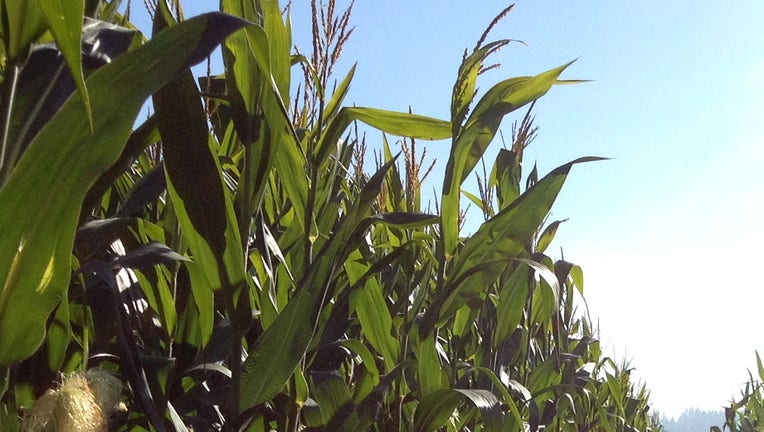So hot in Iowa even the corn is sweating, making for oppressive humidity levels

CLARION, Iowa - The farms of Iowa are the nation's number one supplier of the nation's corn.
But this week, it's exporting oppressive humidity in large quantities.
A phenomenon known as "corn sweat" is combining with a summertime heatwave in the Upper Midwest to make for some unbelievably humid conditions.
Clarion, Iowa, reported a dew point of 90 degrees Wednesday afternoon at 2:15 p.m. Central time. The air temperature at that time was also 90 degrees, resulting in 100% relative humidity and a heat index of 132 degrees.
Some 130 miles west of Clarion in Maurice, Iowa, an even higher dew point of 91 degrees was recorded Tuesday evening between 5-7 p.m. Central time. The 5 p.m. air temperature was 93 degrees, making the heat index an astounding 141 degrees.
However, many meteorologists are skeptical of the 90-degree dew points in Iowa earlier this week. Daryl Herzmann, a systems analyst within the Department of Agronomy at Iowa State University and developer of the Iowa Environmental Mesonet website, tweeted that those observations were "standard failures for the sensor at extreme humidity/temperature levels."
Although the dew point might not have actually hit 90 degrees, there were several more reliable weather stations in Iowa that reported dew points higher than 80 degrees Tuesday and Wednesday, and that's still downright brutal.
What's the best-measured highest dew point? According to an August 2011 blog post by weather historian Christopher Burt at Weather Underground, the highest dew point ever measured in the United States was 91 degrees in Melbourne, Florida, at 2 p.m. on July 12, 1987. That was accompanied by an air temperature of 95 degrees, so the heat index was a stifling 144 degrees.
If Tuesday's 91-degree dew point in Maurice, Iowa, is confirmed as accurate, it would tie that unofficial record from Melbourne in 1987. It's unofficial because Burt noted in his blog that it had not been investigated for accuracy.
The dew point has also reached 90 degrees in the past in Louisiana (1987), Florida (1987) and Wisconsin (1995).
'So hot, even the corn sweats!'
Jamie Foxx or Milli Vanilli might try to blame it on something else, but we'll blame it on "corn sweat."
Iowa has an abundance of corn fields around the state. Corn (or any plant) pulls moisture out of the soil, and some of that moisture escapes through the corn's leaves and enters the surrounding air. This is called transpiration.
Just as humans sweat, or perspire, to cool down, plants are no different. The higher the air temperature, the more the plant will sweat, or transpire. The transpired moisture will then evaporate off the plant's leaves to cool it down, just like how sweat evaporates off human skin. Evaporation is a cooling process.
Additional moisture also enters the air from lakes and other water sources in the area through evaporation. Combine all of this evaporation and transpiration, and you get evapotranspiration.
"Corn sweat" is simply a more colloquial way of referring to evapotranspiration in the vicinity of corn fields.
This process of evapotranspiration leads to increased moisture in the air near corn fields as the corn "sweats" to keep itself cool, ultimately leading to higher dew points in many areas surrounding the corn fields.
So, what does an 80+ degree dew point really mean?
Dew points are used to figure out how much moisture is present in the air. In simplest terms, the dew point is the temperature to which the air must be cooled in order for it to become saturated. It provides a measure of the actual amount of water vapor in the air – so the higher the dew point, the more moisture in the air.
Once the air temperature and dew point meet, the air becomes saturated and the relative humidity reaches 100%. The dew point can never be higher than the air temperature.
Weather conditions affect everyone differently, but a good generalization is that dew points in the 50s or lower are comfortable for most people, 60s are humid and somewhat uncomfortable and 70s are oppressive and very uncomfortable. Once the dew point gets into the 80s – and even to around 90 degrees on these extremely rare instances – it's basically unfathomable unless you've ever experienced that much humidity, which you haven't if you've never left the Pacific Northwest.
In the Puget Sound region, dew points are almost always in the 50s at most, with low-mid 60s on rare occasions. We're lucky here in the Pacific Northwest that oppressive humidity on our hot days is rarely, if ever an issue. Moist air here comes off the cool Pacific Ocean keeping the heat away, and when the marine breezes are held back, the hot weather comes from the arid desert regions that make it a relatively dry heat.
Luckily, "corn sweat" isn't really a thing unless you live in the Midwest, a region covered in corn. The weather station in Clarion, Iowa, that reported a 90-degree dew point Wednesday is located in the middle of a corn field. The station in Maurice, Iowa, that observed a dew point of 91 degrees Tuesday also appears to be surrounded by corn fields. We can certainly blame the "corn sweat" here.
Stay connected with Q13 News on all platforms:
DOWNLOAD: Q13 News and Weather Apps
WATCH: Q13 News Live
SUBSCRIBE: Q13 FOX on YouTube
DAILY BRIEF: Sign Up For Our Newsletter
FOLLOW: Facebook | Twitter | Instagram

